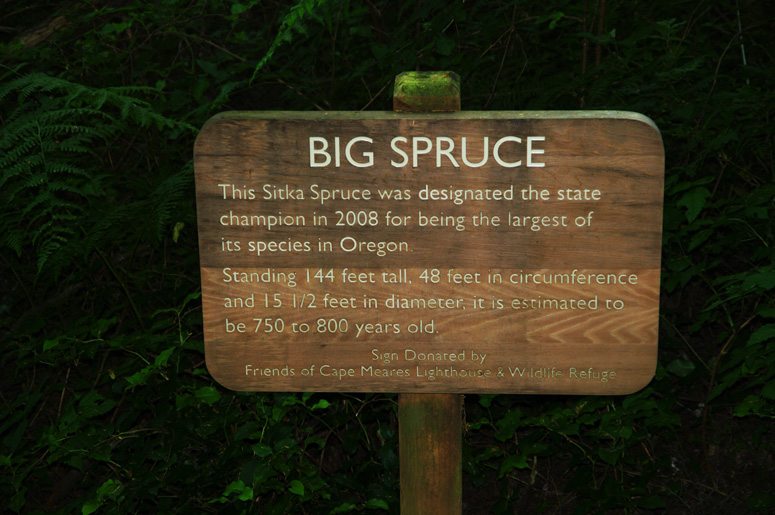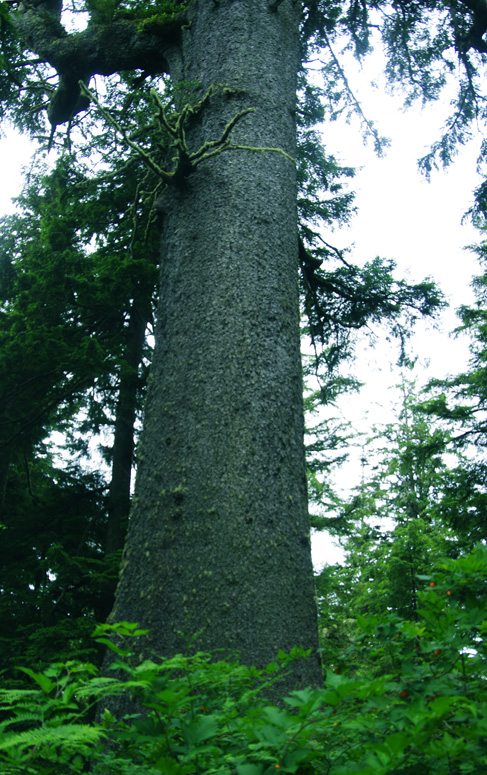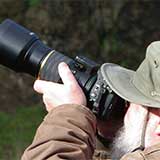Tillamook Coast Life Blog
A tree too big to hug: Cape Meares and its 800-year-old Sitka Spruce
The largest Sitka Spruce, and indeed one of the largest trees of any species currently known in Oregon is located in Cape Meares State Park, a short walk on an easy trail from the park entrance. This is not the “Octopus Tree” also at Cape Meares and a very interesting tree in its own right. This giant was measured in 2008 at “only” 144 feet tall with a broken top, but over 15 feet in diameter, and 48 feet in circumference. Likely it has grown a bit thicker in the past 8 years.

The tree is thought to be 750-800 years old. The broken top is not surprising, as the tree has undoubtedly experienced hundreds of storms with wind gusts over 100 mph in its lifetime. In a forest like this the trees shelter each other from the wind, and any that grow significantly taller than their neighbors are at great risk of broken tops. It has a very large branch (more than two feet in diameter) that goes out 10 feet or so at a right angle to the trunk and then turns upward. Branches such as this are fairly common on broken-topped spruce, and may be attempts to establish a new growing tip and again grow taller.
The tree stands in a small but impressive patch of ancient Temperate Rainforest, the signature climax forest of the Pacific Coast. This stand has numerous spruces 4-8 feet in diameter, and smaller Western Hemlocks and Red Alders scattered among them. Many of the larger spruce flare out in their lower 6-10 feet, with buttresses extending to the larger roots. These are often trees that grew on top of the stumps of much older conifers. As is typical of ancient Pacific Coast forests, this stand has numerous snags and blown down trees. The big spruces are widely spaced with smaller trees between them, and enough light reaching the forest floor to support a lush layer of ferns and shrubbery. Everything but the tree trunks is green – the trees, the shrubbery, the ferns, the lush mats of moss on the branches of the trees.

These forests are mostly evergreen, even the shrubs, and continue growing throughout the year. Where trees have blown over, their wide but shallow root systems are displayed as intricate arcs of tangled roots lifted as much as 15 feet into the air. And even these support life- the ferns and shrubs of the forest floor climb up over these raised root mats, forming arched topiary walls and ever-changing sculptures.
If you come to the coast to escape a summer heat wave, this spot can provide a wonderful experience. It is remote enough that a short walk up the trail will get you out of earshot of most engine noise, and elicit a great sense of nurturing solitude. And likely if you do come to the coast during a heat wave, the outer coast may be wrapped in sea fog. The great trunks will rise up into the mists and the shrubbery will glisten with moisture, strengthening the feelings of immensity and permanence. Wear a jacket and you will feel like staying longer. If you are into photography, bring your widest wide-angle lenses to capture the grandeur of the trees and the forest.
Directions to Cape Meares: Take Third Street west out of downtown Tillamook. At the edge of town it becomes the Netarts Highway, Rte 131. Follow this through Netarts and past Oceanside to Cape Meares State Park, about 12 miles. Do not take the right turn to Cape Meares Village, about 2 miles out of town, as the road from the village up to the Cape is closed.

